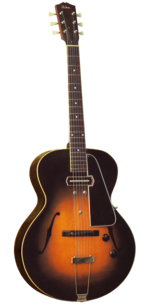Gibson ES-150

Gibson ES 150 "Charlie Christian".
|
|
| Manufacturer | Gibson |
|---|---|
| Period | 1936-1940 (V1) 1940-1957 (V2) |
| Body type | Hollow |
| Neck joint | Set |
| Body | 16 1/4" wide, solid spruce archtop, solid maple back and sides |
| Neck | Mahogany |
| Fretboard | Rosewood with pearl dot inlays, 24-3/4" scale |
| Bridge | Ebony archtop-style bridge adjustable for height |
| Pickup(s) | One steel magnet blade-type single coil in the neck position (Charlie Christian pickup) |
| Sunburst | |
The Gibson Guitar Corporation's ES-150 guitar is generally recognized as the world's first commercially successful Spanish-style electric guitar. The ES stands for Electric Spanish, and it was designated 150 because it was priced (in an instrument/amplifier/cable bundle) at around $150. The particular sound of the instrument was formed by a combination of the specific bar-style pickup and its placement, and became famous due in large part to its endorsement by notable guitar players including Charlie Christian. After its introduction in 1936, it immediately became popular in jazz orchestras of the period. Unlike the usual acoustic guitars utilized in jazz, it was loud enough to take a more prominent position in ensembles. The guitar was produced with minor variations until 1940, when the ES-150 designation (the "V2") denoted a model with a different construction and a different pickup.
The ES-150 was developed and released in association with two US retailers, Montgomery Ward and Spiegel. It was preceded by Gibson adding ancillary piezo pickups to its regular acoustic guitars. The company had developed an electromagnetic pickup in 1935 (the now-famous "bar pickup", named for its shape), which was initially factory-installed only on lap steel guitar (EH) models, then offered as an accessory and finally installed on acoustic guitars (the L-00 and L-1 models).
These electrified guitars proved so successful that soon two retailers, Montgomery Ward and Spiegel May Stern, suggested in summer 1936 that Gibson build the ES model. Montgomery Ward was the first to offer them for sale, as the 1270 model. It had Gibson's bar pickup (though with rounded bobbins, as opposed to the hexagonal pickup Gibson later installed on its own factory models), and a volume control (no tone control); like Spiegel's 34-S model (first advertised in 1937) it lacked any Gibson identification. Spiegel received 42 of these instruments between January and August 1937 before it cut them from the catalog. The contract with Montgomery Ward ran until 1940; an estimated 900 instruments with the 1270 designation were made.
Gibson's "own" ES-150, a "more-upmarket ES model" compared to the Ward and Spiegel models, had minor changes from the contract models, such as a solid carved spruce top, maple back and sides, and an adjustable truss rod. The first guitar was shipped to Bailey's House of Music on November 20, 1936. The instrument sold for $155 including cord, six-tube amplifier, and case. The pickup placement, closer to the instrument's neck than on Gibson's EH steel guitars and on guitars made by other manufacturers, produced a warmer, less "trebly" tone which suited the instrument well for jazz and blues. In 1937, the model's peak year, an average of forty guitars a month were shipped. In early 1937 Gibson also began shipping two other versions: a tenor guitar (the EST-150, with four strings and a 23" scale, renamed the ETG-150 in 1940) and a plectrum version (the EPG-150, with a 27" scale). Early players were Eddie Durham, Floyd Smith and, the most famous of them, Charlie Christian, who bought an ES-150 in 1936. His joining the Benny Goodman Sextet in August 1939 gave it "a near-mythical status" (aided by a feature in that year's December issue of Down Beat).
...
Wikipedia
